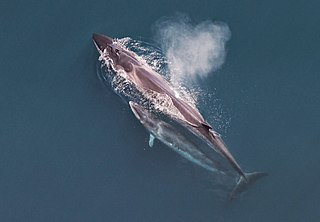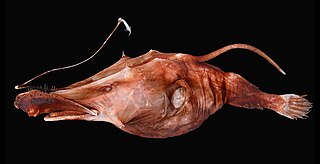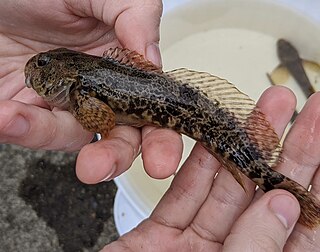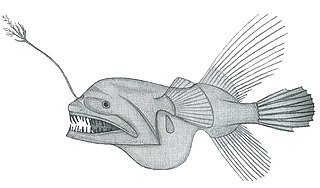
The sei whale is a baleen whale, the third-largest rorqual after the blue whale and the fin whale. It inhabits most oceans and adjoining seas, and prefers deep offshore waters. It avoids polar and tropical waters and semi-enclosed bodies of water. The sei whale migrates annually from cool, subpolar waters in summer to temperate, subtropical waters in winter with a lifespan of 70 years.

The sand tiger shark, grey nurse shark, spotted ragged-tooth shark or blue-nurse sand tiger, is a species of shark that inhabits subtropical and temperate waters worldwide. It inhabits the continental shelf, from sandy shorelines and submerged reefs to a depth of around 191 m (627 ft). They dwell in the waters of Japan, Australia, South Africa, the Mediterranean and the east coasts of North and South America. Despite its common names, it is not closely related to either the tiger shark Galeocerdo cuvier or the nurse shark Ginglymostoma cirratum.

The copper shark, bronze whaler, or narrowtooth shark, is a species of requiem shark, family Carcharhinidae, and the only member of its genus found mostly at temperate latitudes. It is distributed in a number of separate populations in the northeastern and southwestern Atlantic, off southern Africa, in the northwestern and eastern Pacific, and around Australia and New Zealand, with scattered reports from equatorial regions. This species can be found from brackish rivers and estuaries, to shallow bays and harbors, to offshore waters 100 m (330 ft) deep or more. Females are found apart from males for most of the year, and conduct seasonal migrations. A large species reaching 3.3 m (11 ft) long, the copper shark is difficult to distinguish from other large requiem sharks. It is characterized by its narrow, hook-shaped upper teeth, lack of a prominent ridge between the dorsal fins, and plain bronze coloration.

The sea toads and coffinfishes are a family of deep-sea anglerfishes known as the Chaunacidae.

Fanfins or hairy anglerfish are a family, Caulophrynidae, of anglerfishes. They are found in deep, lightless waters of the Atlantic, Indian, and Pacific Oceans.

The dreamers are a family, Oneirodidae, of deep-sea anglerfishes in the order Lophiiformes. They are the largest and most diverse group of deep-sea anglerfish, and also the least well known with 16 genera represented by only one, two, or three female specimens. 62 species within the family, and that contains more females than males. They are found in deep, temperate waters around the world. They are small fish, the largest species only growing to about 20 cm (7.9 in) in total length. The largest female size that’s known is about 370-mm and the largest known male is 16.5 mm. Females are dark brown to black all over their entire body, meanwhile males are also dark brown to black, but the nasal area is not pigmented for them. Female dreamers are found in a preservative dark brown to black color externally except for the escal appendages and distal portion of the escal bulb. Males Also are the same color except in their nasal areas.

The ghostly seadevil or soft leftvent angler, Haplophryne mollis, is a species of anglerfish in the family Linophrynidae and is the only species in the genus Haplophryne. It is found in the bathypelagic and mesopelagic zones of tropical and subtropical parts of the world's oceans at depths down to about 2,250 m (7,400 ft).

Thaumatichthys is a genus of deep-sea anglerfish in the family Thaumatichthyidae, with three known species. Its scientific name means "wonder-fish" in Greek; oceanographer Anton Bruun described these fishes as "altogether one of the oddest creatures in the teeming variety of the fish world." In contrast to other anglerfishes, the bioluminescent lure of Thaumatichthys is located inside its cavernous mouth. They are worldwide in distribution and are ambush predators living near the ocean floor.

Lasiognathus is a genus of deep-sea anglerfish in the family Thaumatichthyidae, with six species known from the Atlantic and Pacific Oceans. It has been called a "compleat angler", in that its lure apparatus appears to consist of a fishing rod, a fishing line, bait, and hooks. It is also distinctive for an enormous upper jaw with premaxillaries that can be folded down to enclose the much shorter lower jaw.

The anglerfish are fish of the teleost order Lophiiformes. They are bony fish named for its characteristic mode of predation, in which a modified luminescent fin ray acts as a lure for other fish. The luminescence comes from symbiotic bacteria, which are thought to be acquired from seawater, that dwell in and around the esca.

Black seadevils are small, deepsea lophiiform fishes of the family Melanocetidae. The five known species are all within the genus Melanocetus. They are found in tropical to temperate waters of the Atlantic, Indian, and Pacific Oceans, with one species known only from the Ross Sea.

Melanocetus johnsonii is a species of black seadevils in the family of Melanocetidae, which means "black whale" in Greek. The species is named after James Yate Johnson, the English naturalist who discovered the first specimen in Madeira in 1863. The common names include humpback anglerfish, humpback blackdevil, and Johnson's anglerfish.

Borophryne apogon, the netdevil, or greedy seadevil, is a species of leftvent anglerfish known today from the waters of the eastern Pacific Ocean off the Central American coast. It is found at depths down to around 1,750 m (5,700 ft). This species grows to a length of 8.3 centimetres (3.3 in) TL. A fossil specimen of this species has been found in the Los Angeles Basin dating back to the Late Miocene, some eight million years ago.

Cottus asper is a species of fish in the sculpin family known by the common name prickly sculpin. It is native to the river drainages of the Pacific Slope of North America from Seward, Alaska south to the Ventura River of Southern California. It extends east of the Continental Divide in the Peace River of British Columbia. It has also been introduced to several reservoirs in Southern California.

Sebastes babcocki is a species of fish in the rockfish family known by the common name redbanded rockfish. Other common names include bandit, barber pole, flag rockfish, Spanish flag, Hollywood, convict, and canary. It is native to the northern and eastern Pacific Ocean. Its distribution extends from the Zhemchug Canyon in the Bering Sea and the Aleutians south to San Diego, California.

The Pacific spiny dogfish is a common species of the Squalidae (dogfish) family of sharks and are among the most abundant species of sharks in the world. This species is closely related to Squalus acanthias and for many years they were treated as a single species. Recent research, using meristic, morphological and molecular data led to the resurrection of Pacific Spiny Dogfish as a separate species. The American Fisheries Society recommends the common name "Pacific Spiny Dogfish" for Squalus suckleyi over alternatives such as "Spotted Spiny Dogfish" and "North Pacific Spiny Dogfish" and "Spiny Dogfish" for Squalus acanthias.

Caulophryne pelagica is a species of fanfin, a type of anglerfish. The fish is found in the bathyal zone at depths ranging from 954 to 2,500 metres.

Caulophryne jordani, commonly known as the fanfin angler, is a species of fanfin, a type of anglerfish. The fish is primarily found in the bathyal zone at depths ranging from 100 to 1,510 metres. it has many unusual tentacles with lights attached.
Caulophryne bacescui is a species of fanfin, a type of anglerfish. The fish is found in the bathyal zone and is known to live in the Peru Trench in the eastern Pacific Ocean.
The longspine chimaera is a chimaera species in the family Chimaeridae. It is found off of the eastern and western coasts of Australia, and lives in tropical and temperate waters 435–1,300 meters deep. Males and females grow to a maximum total length of 93.9 and 103.4 centimeters, respectively, and are brown in color.

















